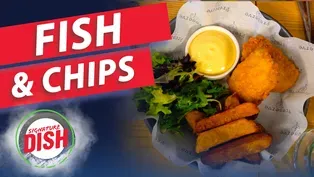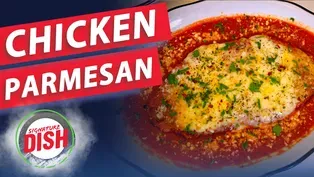Signature Dish
How CIELO ROJO Makes Their Unique Pozole Verde
Clip: Season 2 Episode 1 | 5m 40sVideo has Closed Captions
Step inside the process of making pozole verde at Cielo Rojo!
Seth Tillman explores the process of making pozole verde at Cielo Rojo, a Mexican restaurant in Takoma Park. Chef David showcases the ingredients -- tomatillos, cilantro, pumpkin seeds, dry oregano, bay leaves, epazote, jalapeños, onions, roasted poblano peppers, serranos, and garlic -- which are blended together to create a vibrant salsa verde that is combined hominy, chicken, and chicken broth.
Problems with Closed Captions? Closed Captioning Feedback
Problems with Closed Captions? Closed Captioning Feedback
Signature Dish is a local public television program presented by WETA
Signature Dish
How CIELO ROJO Makes Their Unique Pozole Verde
Clip: Season 2 Episode 1 | 5m 40sVideo has Closed Captions
Seth Tillman explores the process of making pozole verde at Cielo Rojo, a Mexican restaurant in Takoma Park. Chef David showcases the ingredients -- tomatillos, cilantro, pumpkin seeds, dry oregano, bay leaves, epazote, jalapeños, onions, roasted poblano peppers, serranos, and garlic -- which are blended together to create a vibrant salsa verde that is combined hominy, chicken, and chicken broth.
Problems with Closed Captions? Closed Captioning Feedback
How to Watch Signature Dish
Signature Dish is available to stream on pbs.org and the free PBS App, available on iPhone, Apple TV, Android TV, Android smartphones, Amazon Fire TV, Amazon Fire Tablet, Roku, Samsung Smart TV, and Vizio.
Providing Support for PBS.org
Learn Moreabout PBS online sponsorshipSETH: And what is this contraption that we're looking at right here?
CAROLINA: This is our molino, which is a corn mill.
We get corn from different small farms in Mexico.
It used to be just Oaxaca, but now it's like that territory.
SETH: So how does this machine even work?
DAVID: So every day prior to milling, we cook it in a process that's called nixtamalization.
So it just allows the corn to break up and soften, so we can ground it.
It can be digestible.
SETH: And so this corn here, this is going to be used in your tortillas and tostadas and everything else?
CAROLINA: Yeah, I would say the heirloom corn that we use here is at the center of everything we do.
And you can taste the difference and the freshness.
DAVID: In fact, corn is one of the main ingredients for our signature dish, the pozole verde, that I would love to show you.
Why don't we fire this up, and then you can follow me, and we can do it together?
SETH: Sounds great.
Let's do it.
DAVID: All right.
So here we go, Seth.
Welcome to our kitchen in Cielo Rojo.
This is our kitchen set up to make our pozole verde, and these are all the ingredients.
SETH: All right, so pozole, we're talking about a soup or stew here?
DAVID: Yes, yes, absolutely.
So pozole in Mexico, it is the soup of the soups.
It's something that we make, and we gather family, gather people.
It's just party time.
SETH: And a lot more corn too, I can see.
DAVID: Yes, absolutely.
So we have a couple versions of dried corn here.
We nixtamalize corn, we actually also take some of that and cook it a little longer.
And this is hominy, it's just a little bit thicker.
It's like meatier.
So much easier to bite into it.
SETH: Oh yeah, I could snack on that all day.
So these are all the ingredients that are going to actually go into the soup?
DAVID: Yes, absolutely.
We have the star of this dish, which is the tomatillos right here.
SETH: All right, well anytime I see tomatillos in the supermarket, I'm just kind of intimidated.
DAVID: Yes.
SETH: I don't know, are they tomatoes, are they peppers?
DAVID: They're basically similar to a tomato, but they're very different in taste and flavor.
And I'm sure you've had a salsa verde anywhere.
So it's very sour, very acid.
SETH: Giving a nice brightness to the soup.
DAVID: That's correct.
SETH: All right, so how do you put it all together?
DAVID: So here we go.
We got some tomatillos that we're going to go and start putting into the blender.
And then we have some cilantro, some pumpkin seed.
These have been previously toasted.
Some dry oregano.
We have some bay leaves.
And we have some epazote.
Some jalapeños, some onions, some roasted poblano peppers.
And we have some serranos.
These are probably 20 times spicier than the jalapeños.
And we have some garlic.
Now that we have all ingredients here, we're going to go ahead and cover this blender and start blending.
(blending) SETH: So that's it?
DAVID: Yeah, that's it.
Yes.
SETH: This is like the anti-mole, it's so much simpler.
DAVID: Yes.
I think it's probably why we make it all the time, because it's so simple to make.
Just a few ingredients.
Add some hominy, get some toppings, and you have a pozole.
Now that we have our salsa verde blended, we're going to grab a pot and put our sauce.
And then we're going to go ahead and grab our hominy.
We're going to add some chicken and also some chicken broth.
Now that we have our pozole cooked, we're putting everything together.
We have some of the hominy, some green cabbage, some radishes.
We're going to use some of our cashew cream that we're going to put on top of our tostadas.
And we're going to queso fresco, some avocado.
And we also like to add some pico de gallo.
We have oregano, and micro greens to finish up on top.
SETH: Oh chef, this looks incredible.
The color of this dish alone.
DAVID: Yeah, absolutely.
Look at it.
It looks like a Mexican flag, in just that, like the tostadas.
There cannot be nothing more Mexican than pozole.
CAROLINA: And you can't really celebrate pozole without a fresh margarita.
SETH: More beautiful colors.
Well cheers to that.
DAVID: Salud.
SETH: Salud.
Nice and smoky.
All right, I'm going to dig in here.
Oh, wow.
Just excellent.
And for something that is so warm and hearty and comforting, it also gives you such a nice little bracing kick from those peppers, and the acidity from those tomatillos.
Such a nice balance.
And speaking of corn, I see these beautiful tostadas here.
DAVID: Yes, absolutely.
And I'll tell you a story about this.
In Mexico, traditionally as a ritual, we gather with the family and everybody makes a line.
And normally we have all the ingredients, the toppings, and everything aligned, so everybody can just top their bowl and make it to their taste.
SETH: But here, you've nicely done the work for me, so I appreciate that.
DAVID: Yes.
CAROLINA: So if you choose, you can also just crack it and throw it in the soup.
Everybody has a different style of eating pozole.
Typically, or traditionally, people eat it on the side like David.
But I like to break it all in to get a little bit more crunch.
SETH: I love the idea of putting a few more little bits of texture in here.
This whole thing is just, it seems to me a testament to just good quality, fresh ingredients.
CAROLINA: Yeah, I would say that's like the focus point of all of our food here, is that we are a scratch-made kitchen, and we put a lot of love into how we make the food.
And I would say a clear example of that is the hominy.
You know, although it's a lot more work to get the corn from Mexico, to mill it from scratch every day, you can really taste the difference.
How PRESERVE Catches and Cooks Their Fried Blue Catfish
Video has Closed Captions
Clip: S2 Ep1 | 7m 24s | The secret behind Preserve's blue catfish fish and chips. (7m 24s)
Watch CARUSO'S GROCERY Make Their Juicy Chicken Parmesan
Video has Closed Captions
Clip: S2 Ep1 | 4m 11s | Caruso's Grocery shares the secret behind their chicken parmesan. (4m 11s)
Providing Support for PBS.org
Learn Moreabout PBS online sponsorshipSupport for PBS provided by:
Signature Dish is a local public television program presented by WETA













